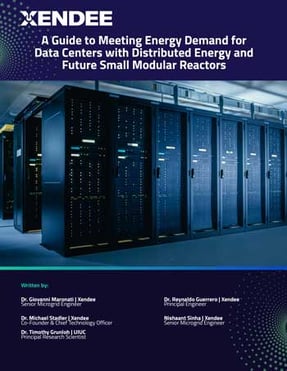Download the Whitepaper
The Data Center Power Surge: AI and Beyond
The rapid growth of data center energy demand, driven by the rise of AI, poses significant challenges for energy infrastructure. By 2030, global data center power consumption is expected to rise by 160%, potentially accounting for up to 8% of U.S. electricity demand. AI servers, with their high computational power, consume significantly more energy—up to 10.2 kW per server—than traditional systems.
Grid constraints, particularly in high-density areas like Northern Virginia’s "Data Center Alley," exacerbate the problem, with transmission bottlenecks and aging infrastructure delaying grid upgrades.
Microgrids powered by Distributed Energy Resources (DERs) provide a viable solution, enhancing energy security, reliability, and power quality while reducing reliance on centralized grids.
However, how you approach a Microgrid solution for a data center project is key to success. A phased approach leverages current DERs, such as renewables and CHP systems, to meet immediate needs while preparing for future integration of Small Modular Reactors (SMRs) as scalable, low-carbon baseload power. This strategy addresses short-term energy demands and ensures sustainable growth.
Using Xendee’s advanced microgrid modeling platform and Mixed Integer Linear Programming (MILP), case studies in Santa Clara, CA, and Ashburn, VA, demonstrate optimized energy investments, OPEX reductions of 60-80%, and significant CO₂ emission cuts while ensuring long-term scalability.
Different Approaches to Powering Data Centers with Microgrids

To illustrate the benefits of an effective multi-year strategy, this analysis compares three distinct approaches to addressing the rising energy demands of data centers:
- Utility-Only Case: In this scenario, no investments in DERs are made during the project. Energy demands are met solely through existing utility infrastructure for the next 20 years.
- Utility with SMR only Case: In this scenario, no significant investments in DERs are made prior to the availability of SMRs. Energy demands are met solely through existing utility infrastructure until 2035*, when SMRs are deployed to provide power. This approach assumes reliance on grid electricity until SMRs are available, which exposes the system to increasing utility costs (also due to system upgrades) and potential carbon penalties as electricity prices rise.
- Multi-Year Approach: This scenario strategically deploys CHP systems and other DERs, such as battery storage, starting in 2025 to meet immediate energy demands. By 2035, SMRs are introduced to supplement and enhance the existing DER infrastructure. This phased approach leverages DER technologies to minimize operational costs, reduce exposure to rising utility rates, and align with decarbonization goals. Please note that this approach also allows for other renewables such as photovoltaics (PV), or wind, but in the case analyzed, PV or wind was not economically attractive, and thus, not selected by the algorithm.
Xendee’s platform supports this phased strategy by designing bankable Microgrid systems that lower costs, reduce CO₂ emissions, and enhance energy reliability and resilience. This ensures that DER systems installed today can seamlessly augment future SMR deployments, creating scalable, sustainable solutions for growing data center demands.
Results and Analysis
Download the whitepaper to access the detailed analysis and results, which highlight the financial and environmental advantages of this strategic, location-tailored approach to DER and SMR integration. The illustrated approach aligns with decarbonization goals while ensuring financial viability, providing a flexible blueprint for sustainable, resilient energy infrastructure across varying regional conditions.



